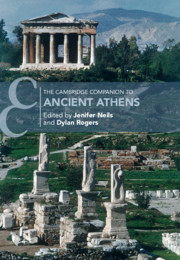Book contents
- The Cambridge Companion to Ancient Athens
- Cambridge Companions to the Ancient World
- The Cambridge Companion to Ancient Athens
- Copyright page
- Contents
- Contributors
- Abbreviations
- Athens: An Introduction
- 1 #Leagros: An Athenian Life
- Part I The Urban Fabric
- Part II Inhabitants
- Part III Business/Commerce
- Part IV Culture and Sport
- 21 The Philosophical Schools
- 22 Athletics, Democracy, and War
- 23 Theatrical Spaces
- 24 Athenian Festivals
- 25 Eating and Drinking
- 26 Sex and the City
- Part V Politics
- Reception
- Index
- References
23 - Theatrical Spaces
from Part IV - Culture and Sport
Published online by Cambridge University Press: 10 March 2021
- The Cambridge Companion to Ancient Athens
- Cambridge Companions to the Ancient World
- The Cambridge Companion to Ancient Athens
- Copyright page
- Contents
- Contributors
- Abbreviations
- Athens: An Introduction
- 1 #Leagros: An Athenian Life
- Part I The Urban Fabric
- Part II Inhabitants
- Part III Business/Commerce
- Part IV Culture and Sport
- 21 The Philosophical Schools
- 22 Athletics, Democracy, and War
- 23 Theatrical Spaces
- 24 Athenian Festivals
- 25 Eating and Drinking
- 26 Sex and the City
- Part V Politics
- Reception
- Index
- References
Summary
This chapter deals with the Athenian buildings aimed at hosting dramatic performances or related to the world of the theater, one of the most important and enduring legacies of ancient Greece to the Western world. The Late Classical Theater of Dionysos at the southern slopes of the Acropolis (second half of the fourth century BC) and the neighboring Odeion of Perikles (mid-fifth century BC) soon became tangible symbols of the city’s wealth and power.
- Type
- Chapter
- Information
- The Cambridge Companion to Ancient Athens , pp. 319 - 331Publisher: Cambridge University PressPrint publication year: 2021
References
Further Reading
The literature on this topic is rich and mainly in German and modern Greek. The problem of the ‘old agora’ and the topography of earlier Athens is analyzed in Miller 1995 (especially 218–219). Of the vast bibliography about the origins of drama, see Csapo and Slater 1994, 79–138, 286–301; Green 1994, especially 16–48; Connor 1996; Sourvinou-Inwood 2003, 141–172; Csapo and Miller 2007, 1–38; Kowalzig and Wilson 2013. Wiles 2000 is a good introduction to the art of Greek theater performance. On the Theater of Dionysos, in addition to the classic Pickard-Cambridge 1946, a recent presentation of the wooden theater can be found in Moretti 1999–2000 and in Papastamati-von Moock 2015, while for the Lycurgan phase, Papastamati-von Moock 2014 is very useful. On the Odeion of Perikles, see Robkin 1976; Miller 1997, 218–242; Shear 2016, 197–228 (for a discussion within the wider framework of Perikles’ building activity). For a discussion of the theatrical spaces of Athens and Attika in the Roman period, see Di Napoli 2013, 7–25.
Bibliography
Additional resources to accompany this chapter can be found at: www.cambridge.org/NeilsRogers

